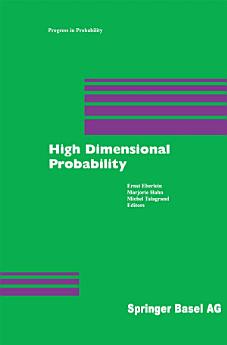High Dimensional Probability
Ernst Eberlein · Marjorie Hahn
ธ.ค. 2012 · Progress in Probability หนังสือเล่มที่ 43 · Birkhäuser
eBook
335
หน้า
reportคะแนนและรีวิวไม่ได้รับการตรวจสอบยืนยัน ดูข้อมูลเพิ่มเติม
เกี่ยวกับ eBook เล่มนี้
What is high dimensional probability? Under this broad name we collect topics with a common philosophy, where the idea of high dimension plays a key role, either in the problem or in the methods by which it is approached. Let us give a specific example that can be immediately understood, that of Gaussian processes. Roughly speaking, before 1970, the Gaussian processes that were studied were indexed by a subset of Euclidean space, mostly with dimension at most three. Assuming some regularity on the covariance, one tried to take advantage of the structure of the index set. Around 1970 it was understood, in particular by Dudley, Feldman, Gross, and Segal that a more abstract and intrinsic point of view was much more fruitful. The index set was no longer considered as a subset of Euclidean space, but simply as a metric space with the metric canonically induced by the process. This shift in perspective subsequently lead to a considerable clarification of many aspects of Gaussian process theory, and also to its applications in other settings.
ให้คะแนน eBook นี้
แสดงความเห็นของคุณให้เรารับรู้
ข้อมูลในการอ่าน
สมาร์ทโฟนและแท็บเล็ต
ติดตั้งแอป Google Play Books สำหรับ Android และ iPad/iPhone แอปจะซิงค์โดยอัตโนมัติกับบัญชีของคุณ และช่วยให้คุณอ่านแบบออนไลน์หรือออฟไลน์ได้ทุกที่
แล็ปท็อปและคอมพิวเตอร์
คุณฟังหนังสือเสียงที่ซื้อจาก Google Play โดยใช้เว็บเบราว์เซอร์ในคอมพิวเตอร์ได้
eReader และอุปกรณ์อื่นๆ
หากต้องการอ่านบนอุปกรณ์ e-ink เช่น Kobo eReader คุณจะต้องดาวน์โหลดและโอนไฟล์ไปยังอุปกรณ์ของคุณ โปรดทำตามวิธีการอย่างละเอียดในศูนย์ช่วยเหลือเพื่อโอนไฟล์ไปยัง eReader ที่รองรับ








